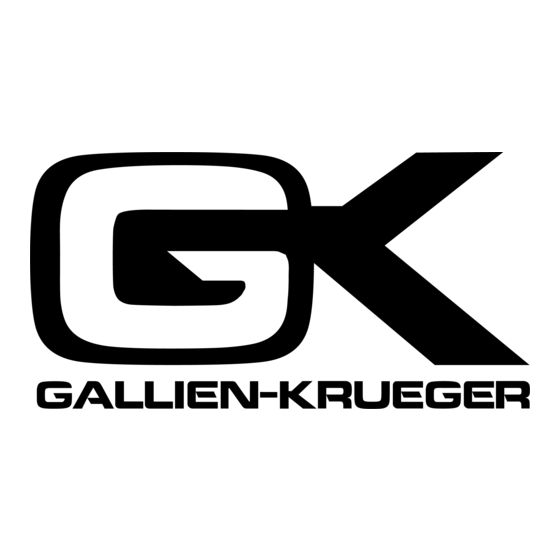Gallien-Krueger 2000RB Betriebsanleitung - Seite 8
Blättern Sie online oder laden Sie pdf Betriebsanleitung für Verstärken Gallien-Krueger 2000RB herunter. Gallien-Krueger 2000RB 12 Seiten.

in the input stage. The CLIP indicator should only light when
you hit your loudest notes. If it stays lit after you have pressed
the -10dB PAD, turn down the volume on your bass.
5. ADJUST VOLUME FOR LOW NOISE OPERATION
Turn up VOLUME(6) as you play, and set it so the CLIP (7)
LED comes on with your loudest notes. Save this setting-it will
give you the best signal to noise ratio. You may have to come
back and re-adjust VOLUME once you have found VOICING
FILTER and ACTIVE EQ settings you like. You may have to
reduce VOLUME (which also determines the SEND level) to
prevent your external effects from being overdriven. You can
now set the MASTER control for comfortable listening.
6. VOICING FILTERS
CONTOUR:
Many players like CONTOUR, so start by setting this control
between 12 and 3 O'clock. CONTOUR drops mids while boost-
ing highs and lows, which creates a "round" sound. If you like a
flatter response ("funk"e.g.)try experimenting with CONTOUR
settings between 9 and 12 O'clock.
BOTTOM:
If you want lots of low end response, try boosting BOTTOM
above 12 O'clock. If you want the tone of older G-K amps, try
setting Bottom between 10 and 12 O'clock.
PRESENCE:
Presence will add "edge" so you can cut through the mix. Try
settings below and above 12 O'clock until you find one you like.
Note: PRESENCE adds high end-too much can also create
unwanted "hiss".
7. ACTIVE EQUALIZATION
Once you have your VOICING FILTER settings, use the
ACTIVE EQ to "tailor" your tone. While you play, adjust each
EQ control all the way up and all the way down from the center
position, until you find settings you like. Let your ears be the
judge. There are no EQ settings that can harm your amp.
8. BOOST 1
Most players use BOOST because it adds "growl" (an effect that
is very noticeable but hard to describe). Start with BOOST 1 set
between 10 and 1 O'clock, and experiment with settings above
and below.
9. BOOST 2 & LEVEL
BOOST 2 (which is only activated by footswitch) gives you a
more pronounced BOOST effect for solos. In the higher set-
tings, BOOST 2 is slightly overdriven. Use LEVEL to set your
volume for solos.
10. MASTER
Now that you have your basic tone, use the MASTER control to
set your loudness(stage volume).
Remember, (20) LEFT-LOW-BRIDGE does the following :
In "Stereo Mode", controls output of LEFT channel. In "Biamp
Mode", controls output of LOW frequency amplifier. In "Bridge
Mode", controls output level of the entire amplifier.
(21) RIGHT-HIGH does the following:
In "Stereo Mode", controls output of RIGHT channel.
"Biamp Mode", controls output of HIGH frequency amplifier. In
"Bridge Mode", this control does nothing.
Using Effects
1. In line with the input
Effects like compression work best when connected in line with
the input of the 2000RB. Many players also connect other
"stomp box" type effects in line with the input because it is so
easy. Except for compression, however, this is not the best con-
figuration for low noise, since it amplifies any noise created in
your effects by the gain of the whole amplifier.
Come out of your instrument with a shielded patch cord, into the
effects unit, and from there into the INPUT of the 2000RB.
2. "Series" effects loop
A "Series" effects loop is a simple and effective way to use
effects like chorus, delay, or reverb with the 2000RB. It is also
the best configuration for a limiter. Putting effects in a "loop"
results in much lower noise than "in line with the input". In a
"series" effects loop, effects are connected in "series" between
the 2000RB's preamp and power amp stages. The "series" effects
loop can be used in any of the 2000RB's operating modes:
"Bridge Mode", "stereo Mode", or "Biamp Mode".
Connect SEND(36) to the "mono" input of an external (effects)
device. Come out of the "mono" output of your effects unit into
RETURN(35). SEND(36) is post VOLUME, and post EQ. If
the SEND signal is too "hot", it can overdrive your effects unit,
and it may be necessary to reduce VOLUME (6) until the
unwanted distortion in your effects goes away.
Note : In a 'Series" effects loop use only the SEND (36) to go to
your effects. Do not try using HI OUT (31) or LO OUT (32) in
conjunction with RETURN (35) because this will cause your
system to oscillate.
8
In
